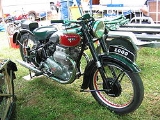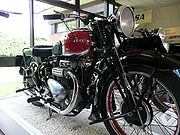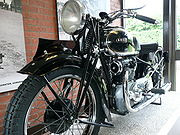
Ariel Square Four
Encyclopedia
The Square Four was an Ariel
motorcycle
designed by Edward Turner
, who devised the Square Four engine in 1928. At this time he was looking for work, showing drawings of his engine design to motorcycle manufacturers. The engine was essentially a pair of 'across frame' OHC parallel twins joined by their geared central flywheel
s, with a four-cylinder
block (or Monobloc) and single head. The idea for the engine was rejected by BSA, but adopted by Ariel. Thus it became the Ariel Square Four.
gearbox.
In 1932, the cylinder bores were enlarged by 5 mm to give a capacity of 601 cc, specifically to accommodate owners who wanted a sidecar. This model was used for the Maudes Trophy
test, covering 700 miles in 700 minutes, followed by a timed lap of 87.4 mph. (In 1923 a Mr George Pettyt, of Maudes Motor Mart, had donated a "challenge trophy" for the ACU to award each year for the most meritorious, observed endurance test for motorcycles, known as the Maudes Trophy
.)
 The “Cammy” engine gained a reputation for overheating the rear cylinder heads, so in 1936 the engine was completely redesigned, emerging as the 1937 OHV 995 cc model 4G. In 1939 Ariel's patented Anstey-link plunger rear suspension became an option.
The “Cammy” engine gained a reputation for overheating the rear cylinder heads, so in 1936 the engine was completely redesigned, emerging as the 1937 OHV 995 cc model 4G. In 1939 Ariel's patented Anstey-link plunger rear suspension became an option.
In 1946, the plunger rear was available again, and oil damped telescopic front forks replaced the previous girder type.
In 1954, Ariel built prototypes of a Mk3 with Earles forks, but the model was never put into production.
In 1959, Square Four production, and that of all other Ariel four-stroke models, ceased.

Ariel Motorcycles
Ariel Motorcycles was a British motorcycle manufacturer based in Bournbrook, Birmingham. It was one of the leading innovators in British motorcycling, and was part of the Ariel marque. The company was sold to BSA in 1944 and the name was discontinued in 1970...
motorcycle
Motorcycle
A motorcycle is a single-track, two-wheeled motor vehicle. Motorcycles vary considerably depending on the task for which they are designed, such as long distance travel, navigating congested urban traffic, cruising, sport and racing, or off-road conditions.Motorcycles are one of the most...
designed by Edward Turner
Edward Turner
Edward Turner was a British motorcycle designer. He was born in Camberwell in the London Borough of Southwark, on the day King Edward VII was proclaimed King....
, who devised the Square Four engine in 1928. At this time he was looking for work, showing drawings of his engine design to motorcycle manufacturers. The engine was essentially a pair of 'across frame' OHC parallel twins joined by their geared central flywheel
Flywheel
A flywheel is a rotating mechanical device that is used to store rotational energy. Flywheels have a significant moment of inertia, and thus resist changes in rotational speed. The amount of energy stored in a flywheel is proportional to the square of its rotational speed...
s, with a four-cylinder
Cylinder (engine)
A cylinder is the central working part of a reciprocating engine or pump, the space in which a piston travels. Multiple cylinders are commonly arranged side by side in a bank, or engine block, which is typically cast from aluminum or cast iron before receiving precision machine work...
block (or Monobloc) and single head. The idea for the engine was rejected by BSA, but adopted by Ariel. Thus it became the Ariel Square Four.
4F (1931–1936)
The first Ariel Square Four 4F was shown at the Olympia Motorcycle Show in 1930, in chain driven overhead-camshaft 500 cc form. Early Square Fours used a hand-change, four-speed BurmanBurman and Sons Ltd
Burman and Sons Ltd, of Ryland Road, Birmingham, England, manufactured Burman-Douglas steering gear.Their recirculating worm and ball design of steering gear was fitted to pre-war vehicles such as the Ford Eight and the Ford Prefect, the Bedford CA, plus many other vehicles - both pre and post-war....
gearbox.
In 1932, the cylinder bores were enlarged by 5 mm to give a capacity of 601 cc, specifically to accommodate owners who wanted a sidecar. This model was used for the Maudes Trophy
Maudes Trophy
The Maudes Trophy is a motorcycle endurance award established in 1923 by George Pettyt, owner of the manager of the Exeter branch of Maudes Motor Mart to promote an impartially observed test for motorcycles. Pettyt donated a silver trophy for the Auto-Cycle Union to award annually.-Winners:...
test, covering 700 miles in 700 minutes, followed by a timed lap of 87.4 mph. (In 1923 a Mr George Pettyt, of Maudes Motor Mart, had donated a "challenge trophy" for the ACU to award each year for the most meritorious, observed endurance test for motorcycles, known as the Maudes Trophy
Maudes Trophy
The Maudes Trophy is a motorcycle endurance award established in 1923 by George Pettyt, owner of the manager of the Exeter branch of Maudes Motor Mart to promote an impartially observed test for motorcycles. Pettyt donated a silver trophy for the Auto-Cycle Union to award annually.-Winners:...
.)
4G (1936–1949)

In 1946, the plunger rear was available again, and oil damped telescopic front forks replaced the previous girder type.
Mark I (1949–1953)
In 1949, the Ariel Square Four Mark I saw the cast-iron cylinder head and barrel replaced by alloy head and barrel. This saved about 30 lb in weight. The 1949 machine weighed around 435 lb (197.3 kg) dry, produced 35 bhp at 5,500 rpm. The Mark I was capable of 90 mph-plus.Mark II (1953–1959)
In 1953, the ‘four pipe’ 997 cc Ariel Square Four Mk II was released, with separate barrels and a re-designed cylinder head, with four separate exhaust pipes. The Square Four was now a genuine 100 mph (160.9 km/h) motorcycle.In 1954, Ariel built prototypes of a Mk3 with Earles forks, but the model was never put into production.
In 1959, Square Four production, and that of all other Ariel four-stroke models, ceased.
Production

| Model | Years Produced | Production |
|---|---|---|
| 4F-500 | 1931–1932 | 927 |
| 4F-600 | 1932–1940 | 2,674 |
| 4G-1000 | 1936–1948 | 4,288 |
| Mk I | 1949–1953 | 3,922 |
| Mk II | 1953–1958 | 3,828 |
| All Models | 1931–1958 | 15,639 |
Pre-war model designations
- 1931-1932: 498 cc 4F/31 Square Four.
- 1932: 498 cc 4F Square Four.
- 1932-1936: 601 cc 4F/600 Square Four.
- 1937-1948: 995 cc 4G Square Four.
- 1939: 599 cc 4F/600 Square Four.

